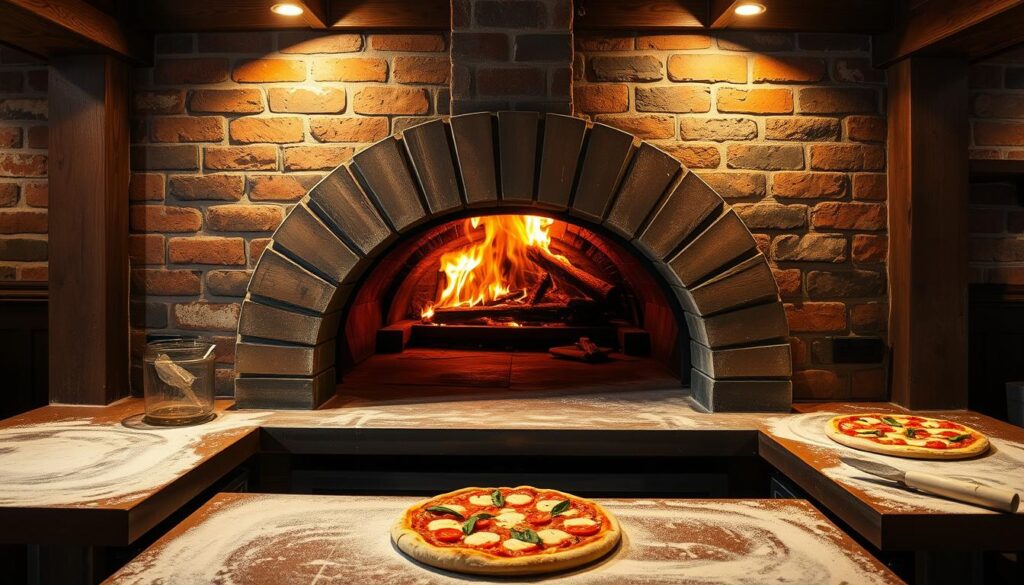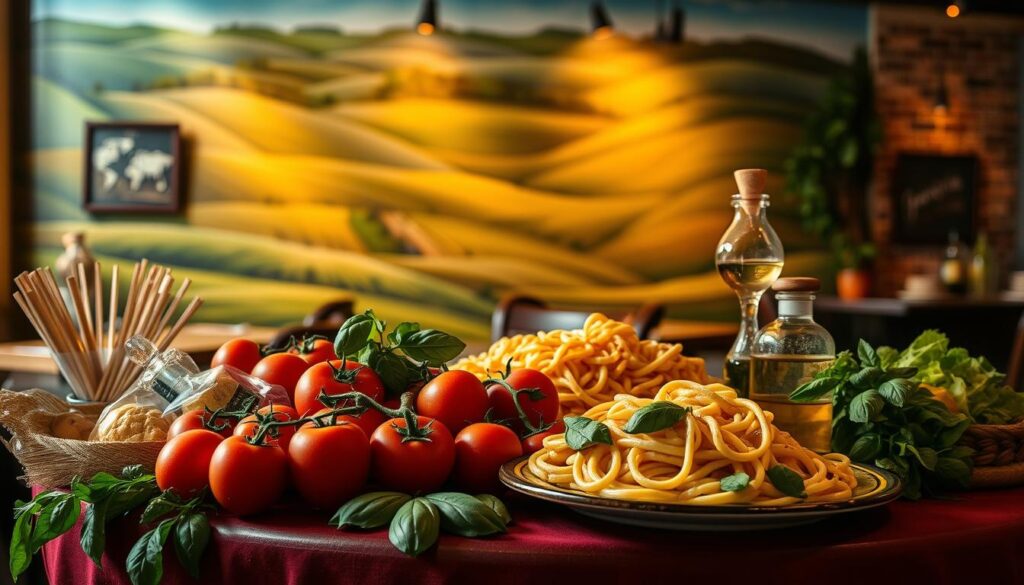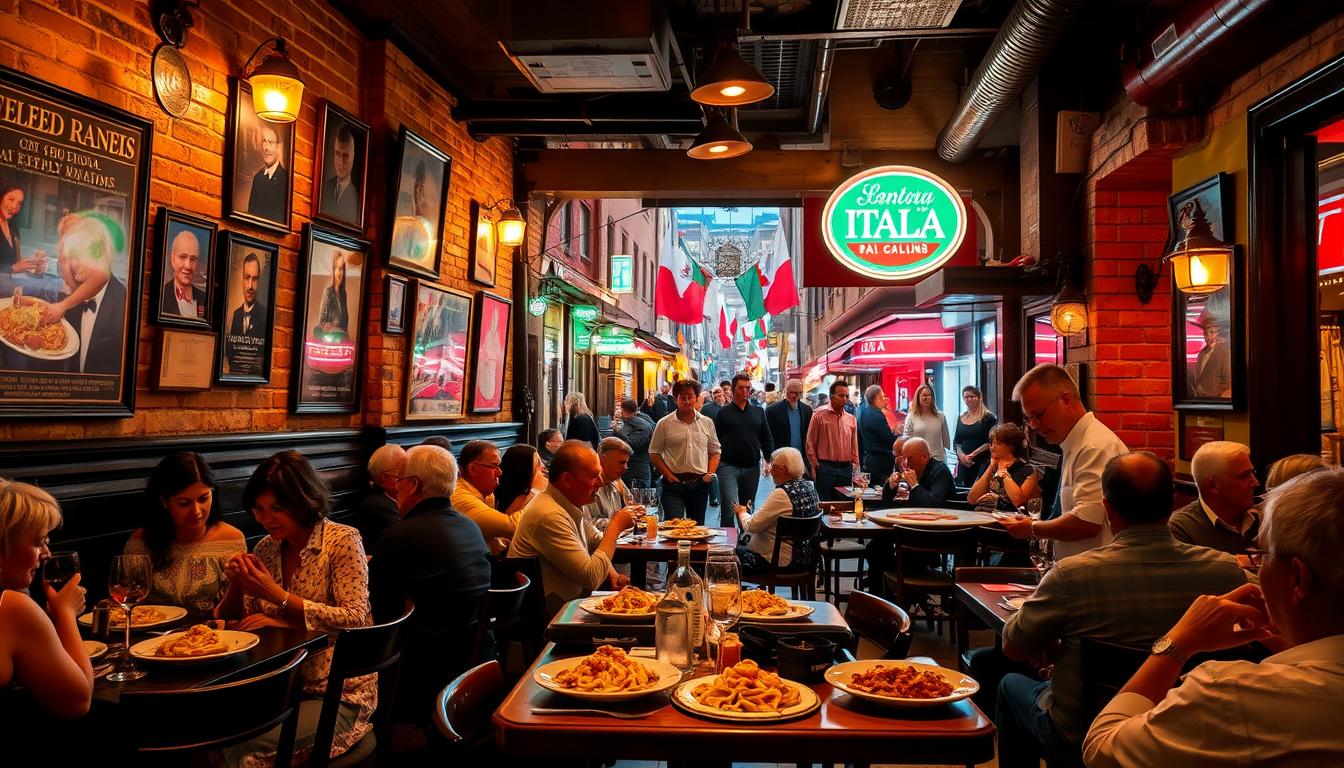Including The Authentic Italian Cuisine in Little Italy
Little Italy is a lively place where real Italian food makes every meal special. It’s in the city’s heart, giving food lovers a true taste of Italy. Here, restaurants share their family’s cooking secrets, bringing Italy’s flavors to your plate.
Looking for the top Italian spot in Little Italy? You’ll find a world of flavors and stories. From cozy family places to fancy dining rooms, there’s something for everyone. Each spot captures the true taste of Italian food Little Italy is famous for.
Dining here is more than just eating. It’s a journey through Italy’s cooking, with chefs using old methods and fresh ingredients. You’ll find homemade pasta, wood-fired pizzas, and great wines. It’s a taste of Italy’s culinary greatness.
Prices fit all budgets, from $15 to $45 per person. This means everyone can enjoy top-notch food without breaking the bank.
What makes Little Italy’s food scene special is its mix of old and new. Chefs keep traditional recipes alive but also try new things. This makes the food scene exciting and always changing, drawing food lovers from everywhere.
Every restaurant has its own story to tell. The warm welcome, cozy settings, and love for cooking make meals unforgettable. You’ll get great service, knowledgable staff, and a feel of Italy’s countryside.
Must-try dishes include homemade ravioli, margherita pizzas, osso buco, and tiramisu. These dishes tell the story of Italy’s rich food heritage.
Discovering the Heart of Little Italy’s Culinary Heritage
Little Italy is a vibrant spot known for its Italian food excellence. It’s one of the best places in the U.S. for Italian meals. The area’s food scene is a mix of old traditions and new ideas.
Historical Evolution of Italian Restaurants in the District
Italian immigrants came to the U.S. in the late 1800s and early 1900s. They brought their cooking traditions with them. These traditions helped create the top Italian restaurants in Little Italy.
- Late 1800s: First Italian immigrant restaurants emerge
- Early 1900s: Family-owned establishments gain popularity
- Mid-20th century: Culinary techniques become more sophisticated
Cultural Significance of Traditional Cooking Methods
Traditional Italian cooking is more than just cooking. It’s about family and culture. Handmade pasta, wood-fired ovens, and family recipes are at the heart of Italian food.
The Impact of Immigration on Local Cuisine
Italian immigrants changed the local food scene. They brought dishes from Naples, Sicily, and Tuscany. This made Little Italy a top spot for real Italian food.
- Introduced regional cooking techniques
- Preserved traditional ingredient sourcing
- Created community-centered dining experiences
Today, Little Italy’s top restaurants honor their history and try new things.
Best Italian Restaurant in Little Italy: Top Establishments Revealed

Little Italy is known for its amazing Italian food. Finding the best place to eat here means exploring the area’s food scene. You’ll find many great restaurants that serve traditional Italian dishes.
Our list of top Italian restaurants in Little Italy shows places known for their quality and taste:
- Bella Cucina – Known for handmade pasta and wood-fired pizzas
- Trattoria Romana – Specializing in classic Roman-style dishes
- Giovanni’s Kitchen – Family-owned restaurant with generational recipes
Each restaurant has its own special touch. When choosing the best Italian restaurant in Little Italy, consider:
- Authenticity of ingredients
- Traditional cooking methods
- Atmosphere and dining experience
- Chef’s expertise
Food lovers will find a wide range of options in Little Italy. You can choose from cozy family-style places to modern takes on classic dishes. These restaurants showcase Italy’s rich food culture.
Prices vary at these restaurants. You can find meals for $20 to $75 per person. This depends on the restaurant’s style and the dishes they offer.
Traditional Pasta Making: From Kitchen to Table
Pasta is at the heart of authentic Italian cuisine in Little Italy. It shows the skill of generations. Making pasta turns simple ingredients into amazing meals that show the true taste of Italy.
Exploring pasta means diving into its world of textures, techniques, and traditions. Chefs in Little Italy keep old ways alive. They make pasta more than just food, it’s a cultural symbol.
Fresh vs. Dried Pasta: Understanding the Differences
Fresh and dried pasta are key to Italian cuisine in Little Italy:
- Fresh Pasta
- Made with eggs and flour
- Softer texture
- Shorter cooking time
- Dried Pasta
- Made with semolina flour and water
- Firmer texture
- Longer shelf life
Regional Pasta Varieties and Their Origins
| Region | Pasta Type | Characteristics |
|---|---|---|
| Tuscany | Pappardelle | Wide, flat ribbons perfect for hearty meat sauces |
| Sicily | Busiate | Spiral-shaped pasta traditionally served with pesto |
| Liguria | Trofie | Short, twisted pasta ideal for seafood dishes |
Signature Sauce Pairings
Finding the right pasta and sauce is key to a great meal. Chefs in Little Italy know each pasta shape has its own story. They pick sauces that match the pasta’s texture and taste.
Authentic Pizza Making Techniques and Wood-Fired Ovens

Pizza making is an art that comes from Italian tradition. In Little Italy, you’ll find restaurants that make pizzas the old way. They turn simple ingredients into amazing dishes.
Wood-fired ovens are key to making great pizza. They get hot, up to 900°F, which gives pizzas a special taste. The heat makes the crust crispy on the outside and soft inside. This is what makes Little Italy’s pizzas so famous.
- Traditional Pizza-Making Techniques
- Wood-Fired Oven Characteristics
- Signature Crust Development
The pizza-making process has a few important steps:
- Hand-stretching dough to just the right thinness
- Using San Marzano tomatoes for sauce
- Picking fresh, high-quality ingredients
- Cooking in wood-fired ovens for 60-90 seconds
| Pizza Style | Cooking Temperature | Unique Characteristics |
|---|---|---|
| Neapolitan | 900°F | Soft center, charred edges |
| Roman | 700°F | Crispy, thin crust |
| Sicilian | 650°F | Thick, rectangular shape |
Pro tip: For the best pizza in Little Italy, find places that use wood-fired ovens and Italian ingredients.
Wine Pairing Excellence in Little Italy’s Finest Establishments
Exploring wine is key to enjoying Little Italy’s top dining spots. Wine pairing turns a simple meal into a special Italian dining adventure. It makes every bite a delight.
Choosing wine is more than picking a drink. It’s a journey that connects you with Italy’s rich traditions. Each glass shares a story of skill, land, and winemaking heritage.
Regional Italian Wines and Their Perfect Food Matches
- Tuscany: Chianti pairs perfectly with rich tomato-based pasta dishes
- Piedmont: Barolo complements hearty meat courses
- Veneto: Prosecco works wonderfully with light appetizers
Understanding Wine Service and Selection
| Wine Region | Recommended Pairing | Flavor Profile |
|---|---|---|
| Sicily | Seafood Dishes | Crisp, Mineral-driven |
| Lombardy | Risotto | Elegant, Soft Tannins |
| Campania | Margherita Pizza | Bright, Acidic |
Top sommeliers in Little Italy’s restaurants see wine selection as an art. They help diners find the perfect wine for their meal. This ensures every sip adds to the dining joy.
Seasonal Menu Changes and Fresh Ingredient Sourcing

Authentic Italian food in Little Italy changes with the seasons. Top spots pick the freshest ingredients for their dishes. Chefs make menus that show off the best of each season, using local and imported items.
Seasonal cooking in Little Italy’s restaurants is more than just changing menus. It shows a commitment to quality and tradition. Chefs work with local farmers and suppliers to get the best ingredients for Italian dishes.
- Spring brings delicate asparagus and fresh peas
- Summer highlights tomatoes, zucchini, and herbs
- Autumn introduces hearty squash and wild mushrooms
- Winter showcases robust root vegetables and cured meats
Local farmers markets are key in this approach. Many top Italian dining spots in Little Italy partner with local farmers. This ensures diners get the best flavors and supports local farming.
Seasonal sourcing is more than a trend—it’s a culinary philosophy that connects diners to the rich traditions of Italian cooking. By changing menus with the seasons, these restaurants offer a lively and engaging dining experience all year.
The Art of Italian Antipasti and Appetizers
Exploring Italian food in Little Italy is a journey through appetizers that prepare you for a memorable meal. Antipasti show the skill that makes Little Italy’s Italian restaurants stand out.
Traditional Antipasti Combinations
Real Italian dining starts with appetizers that excite your taste buds. The classic antipasti spread includes:
- Salumi e Formaggi: Cured meats and artisanal cheeses
- Marinated vegetables (giardiniera)
- Olives and pickled delicacies
- Bruschetta with fresh tomatoes and basil
These traditional dishes show the deep flavors of Italian cuisine in Little Italy’s favorite restaurants.
Modern Interpretations of Classic Starters
Today, chefs in Little Italy are putting a new spin on old favorites. They mix traditional flavors with modern twists in their appetizers.
- Deconstructed caprese salads
- Truffle-infused charcuterie boards
- Fusion appetizers combining Italian and local ingredients
These new takes on classic dishes show the ever-changing nature of Italian cuisine. Each restaurant in Little Italy offers a unique dining experience.
Dessert Specialties and Italian Sweet Traditions

The best Italian restaurant in Little Italy takes you on a sweet journey. It celebrates generations of delicious cooking. Italian desserts are more than just treats; they are a way to honor family traditions.
In Little Italy, you’ll find amazing desserts that show off skill and variety. Each dessert has its own story, blending tradition with new ideas.
- Tiramisu: A classic coffee-infused layered dessert originating from Veneto
- Cannoli: Crispy pastry tubes filled with ricotta cream from Sicily
- Panna Cotta: Silky smooth custard-like dessert from Piedmont
- Zeppole: Delicate fried pastry traditionally served during Saint Joseph’s Day
Desserts in Italy vary by region. Southern sweets are rich and indulgent. Northern desserts are light and elegant.
| Dessert | Region of Origin | Key Ingredients |
|---|---|---|
| Tiramisu | Veneto | Mascarpone, Coffee, Ladyfingers |
| Cannoli | Sicily | Ricotta, Chocolate Chips, Candied Fruit |
| Panna Cotta | Piedmont | Heavy Cream, Sugar, Vanilla |
Today’s pastry chefs in Little Italy mix old traditions with new twists. They make classic desserts modern and appealing to today’s tastes.
Family-Style Dining and Group Experiences
Little Italy’s top italian dining spots celebrate family-style dining. They turn meals into lively social events. Restaurants here offer authentic Italian cuisine, focusing on communal dining that honors cultural ties.
Family-style dining lets guests share big platters of tasty dishes. It encourages talking and bonding. This style mirrors Italian culinary culture, where meals are about sharing and enjoying together.
Private Dining Options and Special Occasions
Many restaurants in Little Italy have special private dining areas for celebrations. These rooms are great for:
- Wedding rehearsal dinners
- Corporate events
- Family reunions
- Birthday celebrations
Private dining rooms can hold 10-50 guests. They offer customizable menus with traditional Italian recipes.
Traditional Family Recipes Preserved
The heart of Little Italy’s dining scene is keeping family recipes alive. Chefs pass down cooking techniques from their grandparents. Each dish tells a story of heritage and love.
These recipes ensure diners taste real Italian flavors. They connect guests to Italian-American cuisine’s rich history.
Understanding Regional Italian Specialties
Exploring the finest italian eatery in Little Italy shows a world beyond pasta and pizza. Each Italian region has its own flavors and cooking ways. These make popular italian food in Little Italy a special food journey.
Italian food is all about regional differences. Each area of Italy has its own special dishes. These dishes reflect local ingredients, history, and culture. Let’s look at some amazing regional specialties:
- Sicilian Cuisine: Known for seafood-rich dishes and bold flavors
- Tuscan Specialties: Featuring rustic ingredients like wild boar and hearty stews
- Venetian Delicacies: Emphasizing fresh seafood and unique risotto preparations
- Piedmontese Dishes: Focusing on rich, truffle-infused recipes
Every region has its own food story. From Southern Italy’s seafood to the North’s alpine ingredients, Little Italy’s restaurants bring these stories to life. You can taste Italy without leaving the neighborhood.
Knowing about these regional differences makes eating more than just a meal. It’s a journey through culture. The best italian eatery in Little Italy shares a piece of Italy’s history with every dish.
Modern Interpretations of Classic Italian Dishes
Little Italy’s top-rated Italian restaurants are changing traditional cuisine. Chefs are making classic dishes new again, keeping the true spirit of Italian cooking alive. This creates amazing dining experiences for food lovers.
In Little Italy, modern Italian restaurants are breaking new ground. They mix old techniques with new ideas. This shows their skill in turning old recipes into new, exciting dishes.
Fusion Influences in Contemporary Italian Cooking
Modern Italian food brings in global tastes while staying true to its roots. Chefs are making dishes that are both new and respectful of old recipes:
- Adding Asian spices to pasta dishes
- Using molecular gastronomy
- Trying out new ingredient mixes
Innovative Cooking Techniques
Top Italian restaurants in Little Italy are using new cooking methods. Chefs are using advanced tech and creative ways to make Italian food better.
| Technique | Description | Impact on Dish |
|---|---|---|
| Sous-vide | Precise temperature-controlled cooking | Enhanced flavor retention |
| Nitrogen Freezing | Instant freezing of ingredients | Unique texture transformations |
| Smoke Infusion | Adding depth through controlled smoking | Complex flavor profiles |
These new methods show how Little Italy’s restaurants keep growing while staying true to their heritage. Exquisite Italian dining is now about telling stories through food, not just following recipes.
Atmosphere and Ambiance: The Complete Dining Experience

Finding the best Italian restaurant in Little Italy is more than just great food. The atmosphere is key to a memorable meal. Top spots in Little Italy aim to recreate Italy’s essence through their ambiance.
Exceptional restaurants offer a full sensory experience. They use lighting, decor, and music to create an Italian vibe. Think soft lights, wooden tables, and Italian tunes to set the mood.
- Warm, intimate lighting creating romantic settings
- Traditional Italian decor with modern touches
- Carefully selected background music
- Attentive yet unobtrusive service
When looking for the best Italian dining in Little Italy, focus on these elements. The top spots know dining is about making memories, not just eating.
| Atmosphere Element | Impact on Dining Experience |
|---|---|
| Lighting | Creates mood and intimacy |
| Decor | Reflects cultural authenticity |
| Music | Enhances emotional connection |
| Service Style | Completes overall experience |
Pro tip: The best restaurants blend authenticity with warmth. They make you feel like you’re in a cozy Italian trattoria.
Sustainability Practices in Little Italy’s Restaurants
The finest italian eatery Little Italy has changed how it serves food. It now focuses on being green while keeping meals top-notch. This way, it honors Italian cooking traditions and cares for the planet.
Restaurants in this historic area are leading the way with green efforts. They show real respect for food and the environment. These steps are more than just saving money; they’re about doing the right thing.
Farm-to-Table Initiatives
Local spots have teamed up with nearby farmers to get ingredients straight from the source. This partnership brings:
- Fresh, seasonal produce
- Less carbon from transport
- Help for local farmers
- Better taste in meals
Eco-Friendly Operations
Little Italy’s eateries are using new ways to cut down on harm to the environment.
| Sustainability Practice | Environmental Impact |
|---|---|
| Composting food waste | Reduces landfill contributions |
| Energy-efficient kitchen equipment | Decreases carbon emissions |
| Reusable/biodegradable packaging | Minimizes plastic waste |
| Water conservation techniques | Protects local water resources |
By adopting these green methods, Little Italy’s restaurants show that authentic Italian cuisine can be tasty and good for the planet.
Special Events and Food Festivals
Little Italy buzzes with life during culinary celebrations. These events show off the rich variety of Italian food. They turn the neighborhood into a lively display of real food and culture.
Food lovers get to enjoy many festivals all year. The top events highlight the best Italian restaurants in Little Italy. They offer unique dining experiences that are more than just eating.
- Annual Pasta Festival: A celebration of handmade pasta varieties
- Summer Wine and Dine Street Fair
- Regional Italian Cuisine Showcase
- Authentic Pizza Making Competition
Local restaurants work together to create unforgettable experiences. These festivals are more than food. They are a journey through Italy’s rich food culture.
| Event Name | Month | Highlights |
|---|---|---|
| Little Italy Food Carnival | July | Street food, live music, cooking demonstrations |
| Harvest Wine Festival | September | Regional wines, artisan cheese pairings |
| Authentic Italian Seafood Weekend | October | Coastal cuisine, fresh seafood specialties |
Visitors can dive into these food celebrations. They get to try popular Italian food in Little Italy and learn about the area’s culture. Each festival is a chance to discover the wide range of Italian food.
Conclusion
Little Italy is a lively place that celebrates real Italian food. It offers a unique dining experience that shows the true heart of Italian cooking. The top Italian restaurants here are more than just places to eat. They are a journey through flavors, techniques, and generations of love for cooking.
Wood-fired pizzas and handmade pastas are just the start. The authentic Italian food in Little Italy shows amazing skill. Restaurants here bring old recipes to life with fresh, local ingredients. This takes diners straight to the Italian countryside.
Exploring Little Italy’s food scene is like discovering a world of flavors and traditions. Each restaurant has its own story, inviting guests to explore Italian food’s rich world. Whether you want a big family meal, a cozy dinner, or a taste of different Italian dishes, Little Italy has it all. It’s a place that truly celebrates the essence of Italian cooking.
Your trip to Little Italy will be a memorable adventure of taste, tradition, and community. Explore the vibrant restaurants, enjoy every dish, and dive into the world of authentic Italian food. This neighborhood is a true gem for food lovers.






